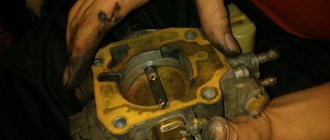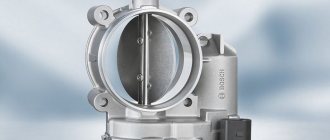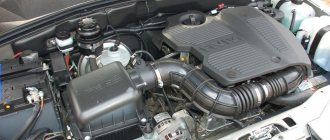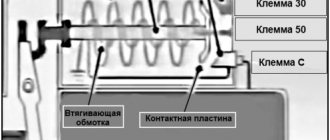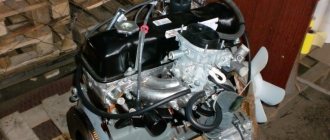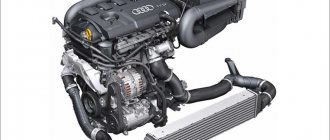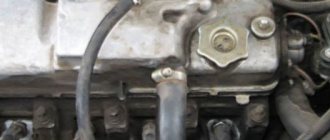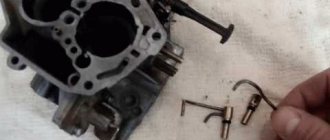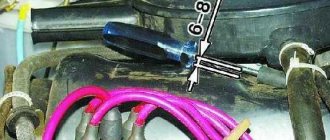Physical aspect of occurrence
It is a mistake to think that the problem is sudden. It all starts with short sharp decreases in engine power, lasting no more than 3 seconds. If the driver does not take any response measures, the duration of the dips increases to 10 seconds. The result of the development of a technical malfunction is a series of jerks or failures. After this, the car will have to be left at the service station for a long time.
Regardless of the age of the vehicle, the causes of failure are the following: clogging of the fuel system due to the use of low-quality fuel or lubricants, breakdown of the ignition system, engine malfunction, breakdown of the carburetor or its individual part.
From a technical point of view, a decrease in the dynamic characteristics of the engine due to failure occurs when the fuel mixture is too or insufficiently enriched. As soon as it appears in the engine cylinders at the moment you press the gas pedal, the heart of the car experiences increased loads. The following signs will tell the driver about this:
- Minimum dip - duration ranges from 1 to 2 seconds. It occurs even when you gently press the gas pedal or when you start moving. In the future, acceleration and maintaining high speeds occurs without problems. The reason lies in the accelerator pump of the carburetor or in the first chamber of the transition system.
- A series of slight jerks - the vehicle jerks several times when the gas pedal is pressed, with or without a subsequent stop. Most often the problem occurs at low and medium speeds. As soon as the driver presses the gas pedal hard, the problem disappears. This can be caused by oxygen leakage from the carburetor, a critical decrease in the fuel level in the float chamber, or clogged emulsion channels or fuel nozzle.
- A series of dips, or rocking, is when the driver notices unstable engine operation under increased and decreased loads. A malfunction occurs due to incomplete opening of the throttle valve in chamber II, a failure of the fuel supply cycle to the carburetor, clogging of the fuel channels or nozzle, or less often due to the ingestion of air by the carburetor.
Development of technical malfunction and repair
The above signs are more than enough to carry out an urgent technical inspection of the car. If everything is done according to the instructions and quickly, then the duration and cost of the repair will not go beyond reasonable limits. Otherwise, the engine speed continues to decrease. The next stage will be a sharp dip that occurs when you press the gas pedal, even at idle.
Regardless of the speed of the vehicle, the speed decreases and a sudden stop is possible. In this case, the acceleration pump or insufficient fuel in the carburetor float chamber must be blamed. This indicates serious wear of individual elements, so it is necessary to immediately begin to eliminate the failure that has arisen.
First, you should inspect the strainer responsible for cleaning the fuel. It is located at the inlet of the carburetor. As it performs its functional duties, it accumulates many types of pollutants. The technical clearance, responsible for supplying fuel to the system, narrows due to accumulated contamination. The result of the current situation is an increase in fuel starvation of the 2114 system.
In addition to low-quality fuel, the process of filter contamination is accelerated by corrosion in the fuel tank and fuel lines. Problems can be resolved by cleaning with a soft-bristled toothbrush. It would be a good idea to blow out the inside of the filter with a jet of compressed air. After this, you need to visually inspect the hole located under the filter. The repair work will be completed by installing the filter in its rightful place.
You will have to tinker more if you find a dirt plug inside the filter. First, you should immediately check the fuel pump and fuel intake filter. Perhaps the problem lies in the corrosion process in the gas tank. It is recommended to walk through the fuel line system that is becoming clogged. Only after eliminating the root cause can you begin to clean the filter.
Troubleshooting complex problems
The appearance of excess air in the carburetor provokes many problems. The main one is a decrease in the saturation of the fuel mixture due to reaction with oxygen. The end result is that the throttle valve does not open fully, causing the engine to stall. Troubleshooting begins with a visual inspection of the hoses and tubes leading directly to the carburetor:
Statistics show that excess air is sucked in due to wear or loose fitting of the tubes. Less often, it is necessary to blame the seat of the solenoid valve. This causes wear on the seal ring. It is much worse if the problem is caused by depressurization of the ignition timing regulator. If no problems are found at this stage, attention switches to the float chamber.
The first place in terms of frequency of occurrence is occupied by excessive enrichment of the fuel mixture. As it enters the engine, it literally floods the spark plugs. If the fuel mixture is too lean, then every time you press the gas, the driver notices a failure. Literally, the engine experiences severe fuel starvation, leading to accelerated wear of its individual parts.
Non-standard reasons
If the power and ignition systems are operating normally, check the air filter and catalyst. In the first case, failures when pressing the gas will be caused by a lack of air, and in the second case, resistance at the exhaust. The catalyst may be clogged or partially melted, causing its flow area to be impaired.
If the injector stalls when you press the gas, it is likely that the reason for this is not a malfunction of a specific unit, but a combination of problems: a clogged fuel filter, air leaks into the intake (you can hear a characteristic whistle in the car when you press the gas pedal), worn spark plugs, etc. .P.
Lack of maintenance provokes multiple malfunctions
Visual diagnostics are carried out as follows. To begin with, the engine idles for 5-7 minutes. After this, the driver removes the carburetor cover, under which the actual fuel level in the chamber is visible. If it is not enough, then immediately add it to the minimum required level.
If a problem cannot be found in the float chamber, then you need to look for it in the air or fuel jets.
Less commonly, the reason lies in emulsion wells.
To eliminate the problem, remove the carburetor cover and do the following:
- remove the fuel nozzle;
- remove the air jet;
- clean both parts;
- rinse and be sure to blow with compressed air;
- rinse and clean the emulsion well.
What are failures?
Solution:
Failure when pressing the gas pedal lies in the improper reaction of the engine to this. Thus, when trying to accelerate, the engine does not gain the required speed .
This leads to a drop in speed. It manifests itself with gradual and sudden acceleration. Dips appear when you press the gas pedal in different ways:
- Short-term failures. There is no response to pressing for a couple of seconds.
- Lingering failures. The engine loses speed for 4 to 10 seconds, and it is possible that the car will stall.
- Jerks. Laps up to 1 or 2 seconds. The car seems to be “twitching”.
- A series of jerks. The engine either increases speed or slows down, although the pedal is in the same position.
- The car jerks. Consists of a series of protracted failures.
Features of failures
What all pedal failures have in common is that when you press the pedal, the engine does not respond in a timely manner, and therefore does not gain momentum. Such failures can appear in different situations and the behavior of the machine can also be different.
So, we can highlight:
- Short dips while driving (no more than a couple of seconds) followed by a quick response from the engine.
- Dips during acceleration.
- Dips at idle speed.
- Prolonged failures, as a result of which the car stalls.
- Jerking, characterized by a series of alternating short dips and subsequent jerks.
There are not many reasons for this phenomenon, so finding and eliminating them will not be difficult for an experienced driver.
Causes of failures when pressing the gas pedal
Let's look at the main reasons:
- Spark plugs and high-voltage wires;
- Clogged fuel injectors;
- The throttle valve is dirty;
- The ignition is set incorrectly;
- Errors in the ECU;
- The air filter is clogged;
- Problems with the fuel pump.
Often, failures occur due to a breakdown of the power system . After pressing the gas pedal, the power system increases the volume of fuel supplied to the cylinders. Breakage causes a change in these proportions. Those. The motor just can't do its job.
In addition, it is possible that there may be a breakdown in the ignition system . It occurs much less frequently. It's either spark plugs or ignition wires. The spark plugs must be removed and checked. The presence of carbon deposits or too clean spark plugs indicate a rich or lean fuel mixture, respectively. This indicates that the ignition system is adjusted incorrectly.
To ensure that the fuel mixture ignites at the right time, read the article on how to set the ignition correctly.
Dips when pressing the gas pedal during acceleration
It is determined both using computer diagnostics and by the steps described below (some of the points below can be performed independently, but specialists in car services in Moscow will be able to determine the problem area more quickly and accurately):
- The first thing you need to do is inspect the spark plugs. To do this you need to remove them. The presence of carbon deposits on the spark plugs, poor contact with the wires, or an excessively lean or rich mixture lead to spark plug malfunctions.
- High voltage wires can also cause engine malfunction, as can ignition coils.
- The throttle needs to be checked. If it is clogged, this causes the engine to respond untimely when pressing the gas pedal.
- It is necessary to check the condition of the air, fuel and oil filters. They tend to get clogged, which worsens dynamics, increases fuel consumption and causes pedal failure. They need to be changed constantly, you can do it yourself, they are inexpensive and easy to install.
- The presence of errors in the ECU leads to failures.
- Clogged injectors. If necessary, replace or repair injectors .
The wires, as well as the rubber bands on them, should not be damaged and should not spark when the engine is running. If damage is found, this indicates that the engine is shaking and jerking begins. This may occur due to the age of the car, worn-out or low-quality spare parts, poor contact with the spark plugs, or due to the temperature of the engine.
The resistance of the coils and the temperature change together, as a result of which a gasoline car begins to jerk during acceleration. In diesel cars, jerking cannot be associated with the coils, since they are not present.
Dips when pressing the gas pedal at idle
Problems also occur at idle speed; of course, there will be fewer reasons. However, this is also a serious problem and cannot be ignored, because... The car will have difficulty starting and simply stall.
Troubleshooting is performed in the following order:
- The first thing to check is the spark plugs. If the spark plugs are faulty, they should be replaced. We recommend replacing all spark plugs at the same time. Buy spark plugs specifically for your engine. If necessary, adjust the gap; it should be 1 mm for 92 gasoline.
- The fuel filter and fuel pump diagnostics are checked. If a malfunction is identified, fix it.
- The breakdown may be in the idle speed sensor.
- Checking the injectors. If clogged, replacement or cleaning is necessary.
- Diagnostics of the ECU for errors.
- Checking the injector.
Dips at idle
Sometimes it happens that when you press the gas pedal, a drop in the speed of the VAZ 2114 occurs at idle (and most often when starting off). The reasons for this phenomenon are quite similar to the reasons for failures in movement.
Let's consider a plan for finding and eliminating them:
- Check the condition of the spark plugs and the gap size. Clean them (how to do this was discussed above) or replace them.
- Check the condition of high-voltage wires.
Checking the armored wires of the VAZ 2114
- Replace the fuel filter (and if the replacement does not help, check the operation of the gasoline pump).
- Check the functionality of the temperature control sensor and idle speed sensor. If they turn out to be faulty, replace them (there is no point in trying to repair the sensors, since they are not repairable).
- Check the electronic unit using a diagnostic adapter and delete errors if any.
Auto diagnostic scanner
- Completely replace the fuel with gasoline from another gas station (very often low-quality fuel causes dips and jerking at idle).
- Carry out diagnostics of the injector.
- Check the condition of the injectors and clean them if necessary.
Dips when pressing the gas pedal - injector
To determine the reasons for the failure of the gas pedal of a raspberry with an injection engine, special equipment is needed, with the help of which diagnostics are carried out. Therefore, to detect a malfunction, you should definitely contact a car service in Moscow.
For the most part, jerking occurs when the fuel supply pressure is low or due to problems with the throttle position sensor.
The pedal falls when the car starts to move
All unpleasant sensations are most often associated with a delayed reaction of the motor to pressing the pedal. Engine stalling often occurs.
The shocks appear when the throttle valve opens, then the sensor gives a signal and the ECU determines at what time to switch from idle to load mode, as well as how much to increase the fuel supply through the injectors. If the pressure is not as high as we would like, and if the injection time is increased, then there will not be enough fuel to move the car.
Also, the cause of jerking may be problems with the electromechanical part of the unit and due to clogging with waste.
Pedal slip during acceleration
Too low fuel supply pressure is the cause of pedal failure during acceleration. Failure can also occur with an automatic transmission due to a lack of working fluid or due to a faulty gearbox.
A car with an automatic transmission accelerates jerkily during its first trip after connecting the battery. This is normal, after a couple of overclocks everything will return to normal.
Dips when pressing the gas pedal on the injector:
The pedal falls when the movement is set
The cause may be a faulty ignition . In this case, diagnostics and repair work are required.
Find out 5 simple ways to avoid being deceived at a car service center. Click on any of the messengers below
